Plasmodium falciparum raf kinase inhibitor is a lipid binding protein that interacts with and regulates the activity of PfCDPK1, an essential plant-like kinase required for red blood cell invasion
IF 2.5
3区 生物学
Q3 BIOCHEMISTRY & MOLECULAR BIOLOGY
Biochemical and biophysical research communications
Pub Date : 2025-01-18
DOI:10.1016/j.bbrc.2025.151350
引用次数: 0
Abstract
Raf Kinase Inhibitor Protein (RKIP) is an important regulator of the MAPK signaling pathway in multicellular eukaryotes. Plasmodium falciparum RKIP (PfRKIP) is a putative phosphatidylethanolamine binding protein (PEBP) that shares limited similarity with Homo sapiens RKIP (HsRKIP). Interestingly, critical components of the MAPK pathway are not expressed in malaria parasites and the physiological function of PfRKIP remains unknown. PfRKIP is expressed throughout the asexual schizogony with maximum expression in late schizonts. Interestingly, PfRKIP and HsRKIP show pH-dependent differential interaction profiles with various lipids. At physiological pH, PfRKIP shows interaction with phosphatidic acid and lipids containing phosphorylated phosphatidylinositol group; however, HsRKIP shows no interaction under the same conditions. Mutation of conserved residues in the PEBP domain of PfRKIP decreases its interaction with PtdIns(3)P. Additionally, in silico docking and mutagenesis studies identified a unique IKK motif within the PEBP domain of PfRKIP that is important for its interaction with the lipids. Using ELISA, we demonstrate the interaction of PfRKIP with PfCDPK1. Importantly, we establish the interaction of PfRKIP and PfCDPK1 within the parasites using immunofluorescence assay and proximity biotinylation technique. Furthermore, our results suggest that PfRKIP regulates the kinase activity of PfCDPK1. In the presence of its substrate, PfCDPK1 hyper-phosphorylates PfRKIP which leads to its dissociation from PfCDPK1. Dissociation of PfRKIP allows PfCDPK1 to trans-phosphorylate its substrates. The molecular mechanism of interaction between PfRKIP and PfCDPK1 may be explored further to identify novel anti-malarial compounds.

求助全文
约1分钟内获得全文
求助全文
来源期刊
CiteScore
6.10
自引率
0.00%
发文量
1400
审稿时长
14 days
期刊介绍:
Biochemical and Biophysical Research Communications is the premier international journal devoted to the very rapid dissemination of timely and significant experimental results in diverse fields of biological research. The development of the "Breakthroughs and Views" section brings the minireview format to the journal, and issues often contain collections of special interest manuscripts. BBRC is published weekly (52 issues/year).Research Areas now include: Biochemistry; biophysics; cell biology; developmental biology; immunology
; molecular biology; neurobiology; plant biology and proteomics

 求助内容:
求助内容: 应助结果提醒方式:
应助结果提醒方式:


